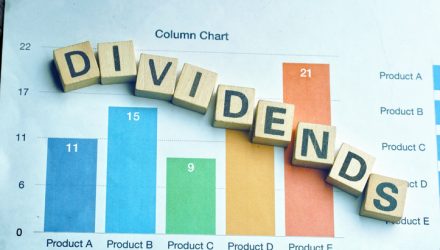What are the best dividend ETF opportunities on the market? This was one of the topics discussed on CNBC’s “ETF Edge” on Monday, with fill-in anchor Seema Mody speaking to Astoria Portfolio Advisors founder John Davi and ETF.com’s Dave Nadig about the best opportunities.
While markets are still on edge after inconclusive trade talks and weakening global data, they are staging a modest rebound from last Friday’s losses. This is only further supported by the increasing odds of another rate cut later this month.
With the hunt for yield still going strong, Mody first asked John Davi about the best dividend plays. He stated how anything involving stock dividend yield, bond yields, etc. are all crowded, expensive, and vulnerable.
Keeping that in mind, when focused on the 10-year, he believes investors like to look at a high dividend yield ETF and don’t quite recognize the risk. Moving from something more secure into the stock equity space means facing more volatility.
“If you must own a high dividend yield ETF,” Davi begins, “What I would say is load it up into a portfolio construction tool; load up into a risk model; find out what your sector weighs, and what your exposures are.”
Davi goes on to highlight three ETFs, not necessarily as an advocation, but to show what to look for. He notes the iShares Core High Dividend ETF (HDV), which features 21% energy stocks, making it pretty risky. The Vanguard High Dividend Yield ETF (VYM) is listed, noting the 18% of holdings in banks and utilities. And there’s the iShares Select Dividend ETF (DVY), which has 40% of holdings in banks and utilities.
Related: 7 Dividend Stock ETFs for a Prolonged Low-Rate Environment
From his personal view, Davi uses the WisdomTree US Quality Dividend Growth ETF (DGRW). It’s more of a dividend growth, high-quality ETF. It screens for companies with above-average ROE and ROA and above-average earnings. The idea being that fundamentals can eventually lead to high dividend growth.
Looking to Dave Nadig, Mody asks about whether or not it makes sense for investors to look to different sectors to take in opportunity involving dividend yield. He agrees that moving into sectors such as banks and energy may be the better play.
“If you look at some of the funds that have very attractive headline yields right now like the Global X Super Dividend ETF (SDIV), that may have a 7 or 8% yield on it, but it’s actually been a terrible performer for a lot of the reasons John was talking about,” Nadig explains.
He goes on to detail how dividends used as a proxy of sorts for cash flow and quality can make a lot of sense. Looking at the First Trust Value Line Dividend Index ETF (FVD), one of the biggest sets of inflows seen this year, it’s only had a headline yield of around 3%, which is very market-like, yet still beating the S&P 500 handily. So again, using dividends as a proxy for quality is more ideal.
Emerging Market Plays
Shifting gears to overseas and the regard for average yield concerning emerging markets dividends, Davi goes into how much he and Astoria like EM and how they are currently overweighted. He believes, much like the US, markets are getting to be fair value. Davi states how he believes in the SPDR S&P Emerging Markets Dividend (EDIV).
EDIV is another dividend grower that screens for companies that have stable earnings and dividends. Additionally, it trades as a discount to EM, with a bit of a higher quality EM tilt.
As Mody points out, while yield is there, the risk with EM revolves around slower growth and trade disputes between the US and China. As Davi notes, when considering the EM margin of safety value, he thinks the US riskier based on the near-decade run it’s been on.
With the European Central Bank meeting this week and the possibility of another Fed cut, trying to assess the trajectory of global rates has some options.
“It just means that you’re really going to have to be struggling if you’re actually trying to live off of these,” Nadig states. “The ideas of people living off the coupons from bond portfolios – that’s pretty old thinking at this point. You’ve got to be thinking about total return.”
Nadig believes things are headed for a flat-to-declining interest rate environment. What matters now is determining what is going to break out once relief finally comes. Something needs to rally, and it won’t show up in coupon payments.
Watch The Discussion Regarding The Best Dividend ETFs:
For more market trends, visit ETF Trends.

